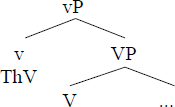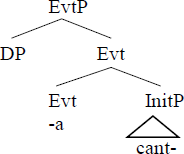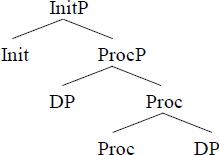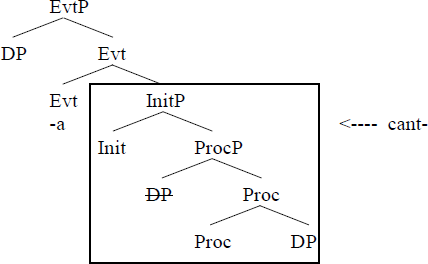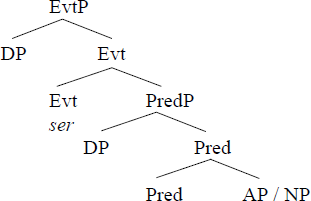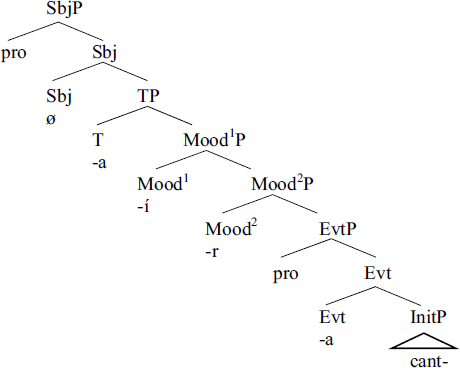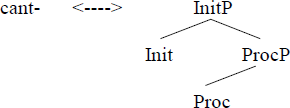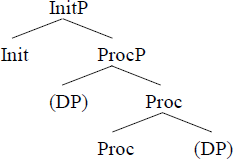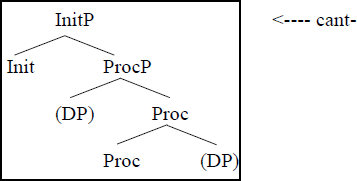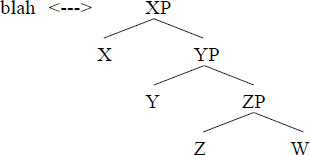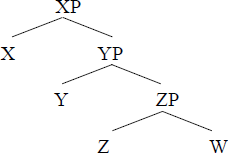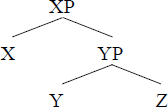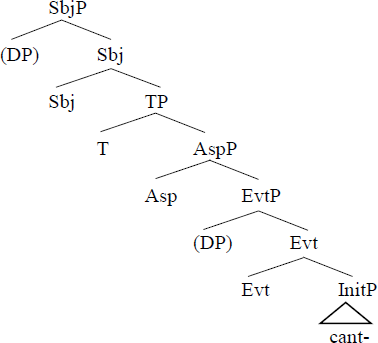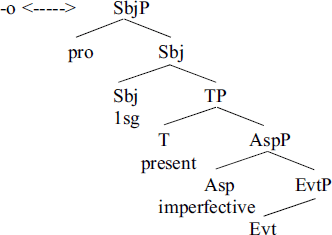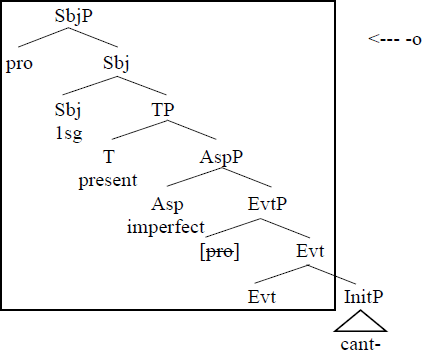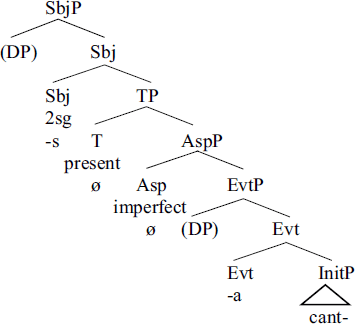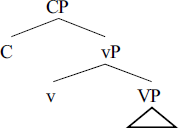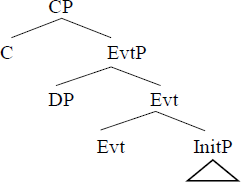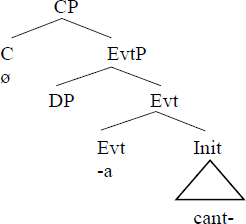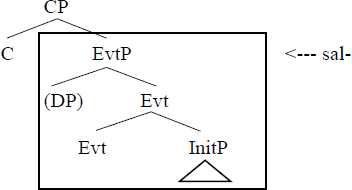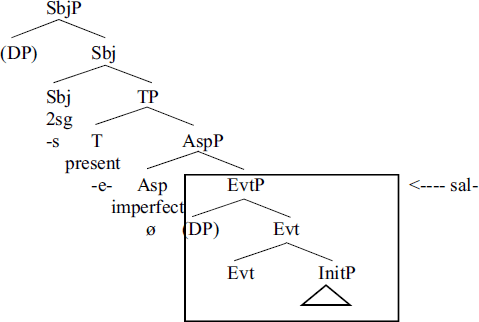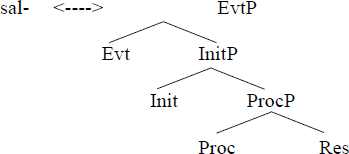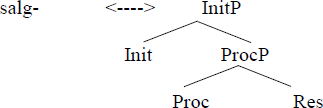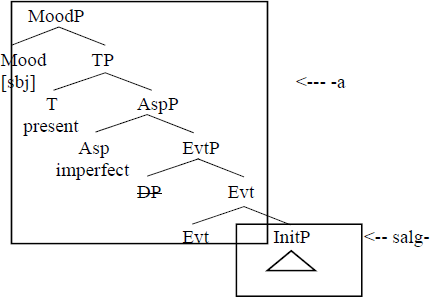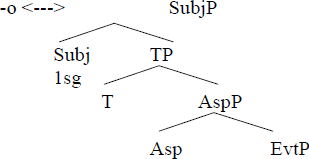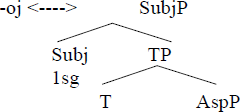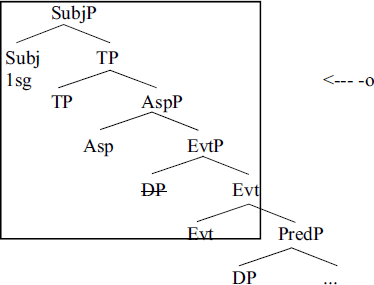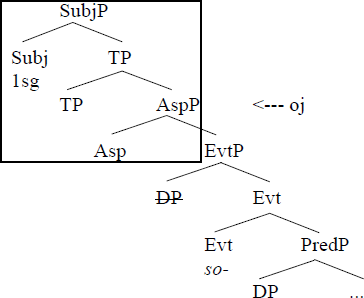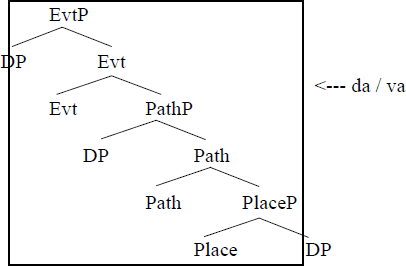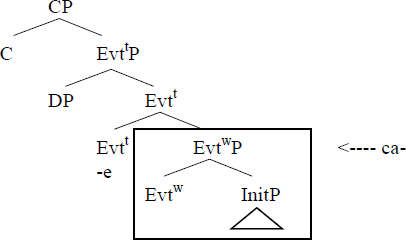1 Problems with Theme Vowels in 1sg forms
There are two main theories about theme vowels (ThVs). In the first one, that we will call ‘ThVs in syntax’, the exponents that we call ThVs are syntactic objects which constitute the spell out of projections that define a lexical verb (Picallo 1991; Kayne 2016; Taraldsen Medová & Wiland 2019). In the second one, ‘ThVs in morphology’, theme vowels are purely morphological objects that either mark verbs in the lexicon or are introduced in some languages in a post-syntactic component related to morphophonological spell out (Oltra-Massuet 1999; Oltra-Massuet & Arregi 2005; Calabrese 2015).
As a preliminary illustration, assume that ThVs are somehow related to a verbal node that we will preliminarily label vP. In the ‘ThVs in syntax’ view (1), the ThV spells out that verbal node directly.
- (1)
In the second view, most strongly expounded by Oltra-Massuet (1999), the ThV is added as post-syntactic morphology in an additional position created by a language-particular rule to functional verbal heads (2): from a syntactic tree (2a), a morphological tree is derived at the PF-branch of grammar, where the ThV position is created (2b) (see Oltra-Massuet 1999; Oltra-Massuet & Arregi 2005; Oltra-Massuet, this volume).
- (2)
- a.
- b.
In this article, I will argue in favour of a refined version of the approach in (1). More specifically, I will argue for the following two points:
a) The morpheme that has been traditionally called the ‘Theme vowel’ in Spanish is the direct spell out of a syntactic head whose role is to adapt a predicate so that it can project in the clausal domain. Following Ramchand (2018), I will label this head ‘Event’ (Evt) and I will assume that its role is to tag the eventuality description with time and world parameters that allow the lexical verb to combine with aspect, mood and tense – that is, to project as a clause in the syntactic spine.
b) In agreement with Oltra-Massuet (1999), I assume that the tradition has given the label ‘Theme Vowel’ in Spanish to only one member within the set of verbal morphemes that mark different functional layers in the verbal extended projection. In other words, inflected verbs may carry more than one ThV (see section 3.2 below for details); the one that has been traditionally labelled ‘Theme vowel’ is only the hierarchically lowest element within this natural class of elements.
In this article, then, I will concentrate on the morpheme traditionally called ‘Theme vowel’, which appears in the infinitival form of the verb (3). I will argue that the traditional ThV is the spell out of a head whose function is to build a Davidsonian eventuality with time and world parameters from the event descriptive heads (Ramchand 2018). I will detail my general proposal, which is developed further in Fábregas (2022), in section 3.1.
- (3)
- a.
- cant-a
- sing-ThV1
- b.
- beb-e
- drink-ThV2
- c.
- viv-i
- live-ThV3
As can be seen in (3), there are three phonological shapes for the traditional ThV: -a, -e and -i. These three ThVs correspond to three traditional conjugation classes, respectively called 1st, 2nd and 3rd conjugation. I will not discuss in this article the alternation between these three conjugation classes. I assume that the three ThVs in (3) are the spell out of the same syntactic head (Evt, as we will see). I therefore treat the distinction between the three ThVs as an idiosyncratic base-conditioned allomorphy, with -a being the default spell out of this head, and specific verbal stems selecting -e or -i as allomorphs (see, however, footnotes 10 and 11 below).
In contrast to Oltra-Massuet (1999), I interpret the (traditional) theme vowel as the direct spell out of a syntactic head, not as a syntactically inert morpheme that is introduced at PF. I will argue for this claim through three verbal irregularity phenomena in Spanish.
a) 1sg present indicative forms are the only present indicative forms that lack a ThV on the surface (4).
- (4)
- cant-(*a)-o
- sing-ThV-1sg, ‘I sing’
b) Some verbs take an irregular exponent, ending in -g-, in the 1sg present indicative form, with the rest of forms being totally regular. These verbs always use the same g-marked exponent for all forms in the present subjunctive.
- (5)
- salg-o
- go.out-1sg
- ‘I go out’
- ~
- salg-a
- go.out-sbj
- ‘that I go out’
c) Finally, a small set of verbs take an irregular allomorph for the 1sg agreement marker (6). These verbs include the copulative forms ser and estar ‘be’.
- (6)
- s-oy
- am, ‘I am’
The rest of this article is structured as follows. In section 2, I will present in some more detail the three empirical problems that I will deal with in this article. In section 3 I will make explicit my assumptions about ThVs, in particular whether I assume that a Spanish verb can have multiple ThVs – with Oltra-Massuet (1999) – and where I locate the one that has been traditionally called ‘theme vowel’ in Spanish, which is the central syntactic object I will discuss here. In section 4, I will discuss the problem in (4) and provide an analysis of why the form -o does not combine with a ThV. In section 5 and section 6, I provide my account of the irregularity pattern involving g-marked exponents (5). In section 5 I will address the 1sg present indicative irregularity, which I will connect with an irregularity in the imperative, and in section 6 I will connect both facts to the irregularity involving the present subjunctive. In section 7, I address the -oy exponent (6), and in section 8 I provide my conclusions.
2 The empirical facts
Let me explain the empirical problems that I have introduced in section 1 above in more detail.
2.1 1sg forms in the present indicative never take a ThV
The problem in (a) refers to the following generalisation:
- (7)
- 1sg forms are the only ones in the present indicative paradigm that lack a theme vowel
In (8) we can see the present indicative conjugation of three regular verbs, one for each of the three conjugation classes in Spanish. As can be seen, the morpheme traditionally called ‘ThV’ is present between the root and the morpheme that marks subject agreement in 5 of these 6 forms. The only form that lacks a ThV is the 1sg form.
- (8)
cant-a ‘sing’ beb-e ‘drink’ viv-i ‘live’ 1sg cant-o beb-o viv-o 2sg cant-a-s beb-e-s viv-e-s 3sg cant-a beb-e viv-e 1pl cant-a-mos beb-e-mos viv-i-mos 2pl cant-á-is beb-é-is viv-í-(i)s 3pl cant-a-n beb-e-n viv-e-n
The reader might wonder if one could assume that the ThV is present in these forms, but it gets phonologically erased in contact with the 1sg marker, which is -o, in order to avoid a hiatus. I will reject this explanation for two reasons. First, in the third conjugation class, the ThV is -i-, which could form a diphthong with -o. However, *vivio is ungrammatical as a present indicative form.
Second, there is at least one verbaliser which consists in fact of a hiatus, -ea(r), as in (9), where -a- is the traditional ThV. No phonological operation erases the ThV in these cases, despite the hiatus.
- (9)
- clar
- clear
- -e
- -vbls
- -a
- -ThV
These facts make me disfavour a phonological solution for this problem, as it would be both insufficient to explain why the ThV -i disappears and too strong in predicting that any hiatus involving the ThV is resolved by removing the ThV.
2.2 An irregularity pattern involving 1sg
The second problem listed above, which I will relate to the first one, is illustrated in (10) and (11). Some verbs use an irregular exponent ending in -g for the 1sg form, here illustrated with sal-i ‘go out’.
- (10)
- Present indicative, sal-i ‘go out’
- 1sg
- 2sg
- 3sg
- 1pl
- 2pl
- 3pl
- salg-o
- sal-e-s
- sal-e
- sal-i-mos
- sal-í-(i)s
- sal-e-n
The present indicative is, then, fully regular for these verbs except for the 1sg form.
Importantly, the same irregular g-marked exponent used for the 1sg present indicative form is used in all forms of the present subjunctive (11).
- (11)
- Present subjunctive, sal-i ‘go out’
- 1sg
- 2sg
- 3sg
- 1pl
- 2pl
- 3pl
- salg-a
- salg-a-s
- salg-a
- salg-a-mos
- salg-á-is
- salg-a-n
This relationship between the irregular exponent used in the 1sg form in the present indicative and the one used in the present subjunctive is a particular instance of a well-known irregularity pattern, identified in Maiden (1992) (see also Maiden 2018, where he advocates for a morphome-based analysis in terms of Aronoff 1994). The irregularity pattern constitutes an L-pattern of irregularity, given the shape adopted by the distribution of the irregular exponent (12).
- (12)
salg-o sal-e-s sal-e sal-i-mos sal-i-(i)s sal-e-n salg-a salg-a-s salg-a salg-a-mos salg-a-is salg-a-n
A fact that, to the best of my knowledge, has not been noted before is that the verbs that follow this L-pattern using a g-marked irregular exponent share another irregularity: they have an irregular 2sg imperative form (which I assume to be the unmarked imperative, cf. Biezma 2010). Specifically, they lose the traditional ThV in the 2sg imperative, as illustrated in (13).
- (13)
- a.
- sal-i
- go.out-ThV
- b.
- ¡Sal!
- go.out.imp
- ‘Go out!’
In contrast to these verbs, the regular 2sg imperative form in Spanish keeps the traditional ThV.
- (14)
- a.
- part-i
- leave-ThV
- b.
- ¡Part-e!
- leave-ThV.imp
- ‘Leave!’
In this article, I will relate these three irregularity facts together, and connect them with the property in section 2.1, namely that 1sg present indicative forms lack a traditional ThV.
2.3. An irregular desinence for 1sg forms
The third problem that I will address here is the existence of an allomorph -oy /oj/ for the 1sg in a number of highly functionalised verbs in Spanish, such as the copulative verbs in (15).
- (15)
- a.
- ser ‘to be’ > s-oy
- b.
- estar ‘to be’ > est-oy
In a nutshell, I will argue that all the facts that I have introduced in section 2.1–section 2.3 can be connected in an explanatory way. The problem in all these cases reduces to this: the object traditionally called ‘Theme vowel’ in Spanish is the spell out of a Voice-head (which I label, following Ramchand 2018, Evt for ‘Event’), and these three instances of apparent irregularity involve situations where that head is spelled out by the verb stem. What happens in the 1sg form of the present indicative is that the exponent -o is the only verbal agreement marker that also spells out Evt. At the same time, in irregular verbs like sal-i-r ‘go out’, the exponent sal- spells out the verb together with Evt, while the irregular exponent salg- is used when the Theme Vowel is not spelled out. The 2sg imperative is plain sal because the verb projects only up to Evt. In contrast, 1sg forms require salg- because -o spells out Evt. The same exponent salg- has to be used in the subjunctive because the subjunctive marker, like 1sg -o, also consumes Evt and forces the same verbs to use the syntactically smaller salg- exponent. Finally, verbs that use -oy for the 1sg are verbs which must spell out Evt, forcing insertion of a different 1sg exponent that does not include Evt.
But first, I will present the assumptions that I adopt in my analysis.
3 Assumptions about Spanish Theme Vowels and the spell out procedure
Before I get into the details of my analysis, let me first present my assumptions about what ThVs are in Spanish. I will closely follow the proposal made in Fábregas (2022), to which I will refer the reader for details when space constraints force me to do so. In this overview of my assumptions, I will try to answer the following questions, proposed by the editors to the authors included in this volume as a guideline to facilitate comparison between the different approaches that we represent.
- (16)
- a.
- How are ThVs defined, and to what set of grammatical formatives does this label traditionally apply in the language(s) under discussion?
- b.
- Does this set of formatives make up a uniform, coherent class in terms of modern generative theorizing or does this set split up into two (or more) grammatical entities?
- c.
- Can ThVs (in the language(s) in question) be exhaustively reduced to a set of otherwise well-known and productively used categories and operations in one or more components, or do they qualify as a grammatical entity with its own characteristics?
- d.
- Which components/modules of the chosen grammatical architecture are involved (e.g. Core Syntax, PF in DM)?
- e.
- How can the emerging classes be described in terms of independently needed categories and operations?
I will try to answer these questions in the paragraphs that follow, in this order. I provide my answer to (16a) in section 3.1, where I detail how my framework (Fábregas 2022) treats the traditional ThV as the spell out of a specific syntactic head that makes the lexical verb combinable with the clausal projections. I will provide my view about (16c–e) in section 3.2, where I discuss the larger class of elements where the traditional ThV is included. Section 3.3 briefly presents my assumptions about how spell out works, which I take from Nanosyntax (Caha 2009).
3.1 What is the traditional ThV in Spanish?
As I have advanced, in my view (see also Fábregas 2022: 35–40), the object that has been traditionally called the ThV in Spanish – highlighted again in (17) – is the spell out of the head that builds a complete eventuality1 out of the eventuality-descriptive heads.
- (17)
- cant-a
- sing-ThV
- ‘sing’ (stem)
This means that the traditional Theme Vowel in (17) is the spell out of a syntactic head, whose role is to turn the lexical verb into an eventuality that has time and world parameters, and, as such, the traditional ThV is nothing but the spell out of part of the verb’s functional structure that projects it into a clause. Let me be more specific about this claim by labelling the projection that I take to correspond to the traditional Theme Vowel in (17). The basic structure that I assume for (17) is represented in (18). Here, the theme vowel corresponds to Ramchamd’s (2018) Event Phrase, and the verbal stem is the spell out of the event-descriptive heads Init, Proc and Res.
- (18)
Following Ramchand (2018), I assume that the event-descriptive heads Init, Proc and Res are responsible for introducing a partial description of an eventuality that lacks time and world parameters. Init, Proc and Res define different subphases from an eventuality. In the specific case of cant- ‘sing’, I assume that the verb defines a Proc(ess) part consisting of a dynamic extended subphase, and an Init(iation) part which defines a causing subevent. In terms of argument structure, Proc selects a possible incremental theme that measures the dynamic part of the event and Init defines an external argument of the eventuality as an agent. (19) represents this part of the verbal structure.
- (19)
I assume that in a regular verb (19) is spelled out as cant-, that is, as the verbal stem without the traditional ThV (see section 3.3 below for a detailed presentation of my assumptions about spell out).
(19) does not correspond, however, to an eventuality in the way in which it has generally been interpreted since Davidson (1967). The reason is that (19) defines theta roles and Aktionsart – that is, it has provided a description of what the eventuality should look like in the real world – but lacks the parameters of time and world that allow this eventuality to be anchored to tense and be modified by mood and aspect. In other words, (19) cannot be projected into a clause because it lacks the time and world dimension that is required to combine with AspectP, MoodP and TenseP.
In Ramchand (2018), the head that adapts (19) – a predicate – so that it can project into a clause is the head Evt. This head acts as a function that takes an event description and gives as a result an eventuality that is tagged for time and world (see also Fábregas & González Rodríguez 2020), and can therefore further combine with Asp, T, and the rest of the functional nodes that build a clause in Spanish.
- (20)
Evt does not have any descriptive property, and simply provides syntactic space for the external argument, whose entailments depend on the projection that Evt takes as complement. In (19), that external argument in spec, EvtP, is interpreted as an initiator – agent, causer or instrument – because the InitP layer imposes that interpretation on the specifier of EvtP, but in its absence the external argument would be interpreted as a patient, as ProcP or ResP would be the complement of Evt.
In this sense, EvtP has a role similar to VoiceP in Harley (2013) or Alexiadou, Anagnostopoulou & Schäfer (2015): a head that profiles the eventuality providing space for a participant that is promoted to the subject position, but which does not provide descriptive content to the eventuality. The crucial difference between Ramchand (2018) and these other works is that the equivalent of little v in Ramchand (2018) lacks information about time and world, so that in her theory, the equivalent to VoiceP is the head that provides this information to the lexical verb.
Then, my answer to (16a) is summarised in (21).
- (21)
- The morpheme traditionally called ‘ThV’ in Spanish is the spell out of a functional verbal head that adapts the predicate so that it is possible to build a clause on top of it.
The role of Evt in Ramchand (2018) is very similar to what copulative verbs are generally taken to be: as copulative verbs, Evt takes a predicate that is not defined as a full verb yet –because it lacks time and world parameters – and provides it with what is missing so that a clause can be built on top of it. Unlike what happens with the copula in Russian or Arabic, the Spanish copula must be present in any tense, aspect and mood, irrespective of polarity. My claim is that the traditional ThV in Spanish does the same as the copulative verb in (22b). (22a) is as ungrammatical as a (regular) verb in Spanish without the ThV.
- (22)
- a.
- *Juan
- Juan
- alto
- tall
- /
- *Juan
- Juan
- cant
- sing
- b.
- Juan
- Juan
- {es / está}
- isser / isestar
- alto.
- tall
- Juan
- Juan
- cant-a
- sing-ThV
- ‘Juan is tall’ ‘Juan is singing’
Let me summarise some of the evidence that I present in Fábregas (2022: 40–45) in favour of this idea that the traditional Spanish ThV performs the same role as the copulative verb. In essence, I claim that both copulative verbs and the traditional ThV in Spanish perform the same function – adding time and world parameters to a predicate that lacks them – and occupy the same position, Evt.
This means that copulative verbs and traditional ThVs occupy the same position in Spanish, which means – in particular, if the traditional ThV is the direct manifestation of a syntactic head – that copulative verbs must be verbal forms without a traditional ThV –because the verb is the spell out of the same head that in a regular verb is spelled out as the ThV.
I believe that this prediction is borne out. Spanish traditionally has two copulas. The verb ser ‘to be’, used in general for identificational and individual level predicates (Carlson 1977), has a present indicative form where it is impossible to identify any of the three theme vowels in Spanish, /a/, /e/ or /i/.
- (23)
- 1sg
- 2sg
- 3sg
- 1pl
- 2pl
- 3pl
- s-oy2
- ere-s
- es
- so-mos
- so-is
- so-n
In the present indicative form of this verb, when we segment the agreement markers, the remaining material does not provide evidence for the presence of a theme vowel. My claim is that this verb lacks a traditional ThV. The reason is that ser is already introduced in EvtP, in order to adapt the predicate so that a clause can be built on top of it. As the ThV performs the same function, this verb does not have a ThV because – so to say – the verb itself is a theme vowel.
The verb estar ‘to be’ is the second Spanish copula, generally used for stage level predicates and spatial locations (Carlson 1977; Arche 2006). Despite appearances, in Fábregas (2022: 43) I show that the right segmentation is not (24a), with a ThV, but (24b), where the final /a/ is part of the verbal stem, and thus that this verb lacks a theme vowel.
- (24)
- a.
- est-a-r
- b.
- esta-r
My first piece of evidence is that the perfective form of this verb is not the one that one expects from a 1st conjugation verb in /a/. If we compare (25a) to (25b) and (25c), we see that the verb inflects in the perfective as a verb from the 2nd or 3rd conjugation.3
- (25)
- a.
- estar
- to.be
- >
- estuv-i-ste
- be-ThV-2sg.pfcv ‘you were’
- b.
- cantar >
- to.sing
- cant-a-ste
- sing-ThV-2sg.pfcv ‘you sang’
- c.
- beber >
- to.drink
- beb-i-ste
- drink-ThV-2sg.pfcv ‘you drank’
This contrasts with a verb like andar ‘to walk’, which in theory has the same (normative) perfective form (26), but where speakers have a very strong tendency to regularise to a form parallel to (25b), the one in (27a). Importantly, to the best of our knowledge the regularised form for estar is unattested (27b), showing that speakers do not treat the verb as a 1st conjugation form at any level of analysis.
- (26)
- andar >
- to.walk
- anduv-i-ste
- walk-ThV-2sg.pfcv
- ‘you walked’
- (27)
- a.
- and-a-ste
- walk-ThV-2sg.pfcv
- ‘you walked’
- b.
- *est-a-ste
- be-ThV-2sg.pfcv
- Intended: ‘you were’
Secondly, in the present indicative, the verb estar does not inflect as a verb with a ThV. Note in particular the stress pattern of estar in contrast with a regular verb of any conjugation (28). The singular forms and the 3pl form of estar have stress on the last syllable, in contrast to regular verbs.
- (28)
- a.
- b.
- c.
- d.
- e.
- f.
- estoy
- estás
- está
- estamos
- estáis
- están
- /estój/
- /estás/
- /está/
- /estámos/
- /estájs/
- /están/
- 1sg
- 2sg
- 3sg
- 1pl
- 2pl
- 3pl
- canto
- cantas
- canta
- cantamos
- cantáis
- cantan
- /kánto/
- /kántas/
- /kánta/
- /kantámos/
- /kantáis/
- /kántan/
The pattern in (28) supports an analysis where the final /a/ of estar is not a ThV. In their analysis of verbal stress in Spanish, Oltra-Massuet & Arregi (2005) propose that in the present indicative form of the verb, stress is assigned by projecting the right boundary of a metrical foot to the left of the tense morpheme, which in the present tense is a zero exponent (29a), and building an iambic foot from it (29b).
- (29)
- a.
- x
- cant
- x
- -a
- )
- -øT
- -mos ‘(we) sing’
- b.
- x
- cant
- x
- x
- -a
- )
- -øT
- -mos
However, this rule does not predict the position of stress for the singular forms and the 3pl form of a regular verb like cantar, as it would predict forms with stress on the last vowel, such as *cantá, *cantán. To solve this, Oltra-Massuet & Arregi (2005: 60–62) propose that Spanish has an idiosyncratic rule that erases the prosodic unit corresponding to the theme vowel in the singular forms and the 3pl form of the present indicative. Then, the theme vowel does not project into a metrical grid, and stress is shifted one position to the left, producing the attested stress forms.
- (30)
I take this rule to be correct, as it explains in an elegant way the stress pattern of the vast majority of verbs in the present indicative. However, this rule does not apply to estar, where forms like está, están are the correct ones, as shown in (28). Why? My proposal is simply that this rule does not apply to estar because the rule erases the position related to ThVs, and the final -a of estar does not correspond to a ThV. Therefore, the prosodic position related to this -a is not erased, there is no stress shift, and stress always appears – as the algorithm predicts – in the segment immediately preceding the agreement marker.
I believe that there are also strong empirical reasons to also treat estar as a verb that lacks a traditional ThV. In my analysis, this is explained because traditional ThVs and copulative verbs compete for the same position, which is Evt.4 (31) represents my structure for copulative verbs. I assume with Baker (2002) that non-verbal predicates introduce their subject through functional structure, specifically Bowers’ (1993; 2001) Predication Phrase.5
- (31)
3.2 How many ThVs can a verb form have in Spanish?
I will now address questions (16b) and (16c), which have to do with how grammatically homogeneous ThVs are in the language in question. Let me start by saying that I believe that it is quite evident that the objects that have been labelled ‘Theme vowels’ across languages do not display a homogeneous set of empirical properties.
Taraldsen Medová & Wiland (2019) have argued that thematic formatives in Czech and Polish can be matched with aspectual properties, and Garet (2021) has shown that French -i- interacts with prefixes in order to define a coherent class of lexical predicates with a defined set of scalar, aspectual and argumental properties. This has nothing to do with the behaviour of (traditional) ThVs in Spanish, where the same ThV is compatible with verbs of every aspectual or argumental class (see 32, as an illustration).
- (32)
- odi-a ‘hate (state, transitive)’, nad-a ‘swim (activity, unergative)’, explic-a ‘explain (accomplishment, transitive)’, lleg-a ‘arrive (achievement, unaccusative)’, salt-a ‘jump (semelfactive, unergative)’, adelgaz-a ‘lose weight (degree achievement, transitive or unaccusative)’…
Beyond the fact that ThVs have been defined as morphemes that attach to verbs, I do not think there is any cross-linguistic grammatical property that allows us to say that the label ‘Theme vowel’ has been applied to a grammatically-defined natural class of elements.
If we now look internally to Spanish, however, there is some generalisation that can be stated. As the reader will have noticed, I have been using the term ‘traditional ThV’ to refer to the element that appears in the infinitival form. The reason is that I follow Oltra-Massuet (1999) in her claim that the element traditionally classified as ThV in a language like Spanish is only one of the members of a larger set of elements that appear in verbal forms. I assume with Oltra-Massuet (1999) that an inflected verbal form may have more than one ThV. In particular, I accept Oltra-Massuet’s claim that in a conditional form like (33) there are three theme vowels that can be isolated.
- (33)
- cant-a
- sing-ThV
- -r
- -mood
- -í
- -ThV
- -a
- -ThV
- ‘I would sing’
In Oltra-Massuet (1999), the traditional theme vowel is part of a set of morphemes whose role is to mark the functional structure of the verb. In her analysis, the traditional ThV is the marker of the verbal categorising head, but heads corresponding to (grammatical) aspect, tense and mood can also be tagged with ThVs. I accept Oltra-Massuet’s claim that theme vowels appear also as manifestations of tense, mood and grammatical aspect. In fact, in my analysis of forms like sal-e-s ‘you exit’ (cf. section 5.1), I will argue that the ThV -e- that is visible in the verb is a projection of T, not Evt. Note also that in my proposal it is crucial that other verbal heads beyond Evt introduce ThVs in Spanish, because forms that do not correspond to the present indicative of the copulative verbs ser and estar exhibit clear instances of ThVs (34). I take these ThVs to be the spell out of higher clausal projections corresponding to tense, aspect and mood.
- (34)
- a.
- estuv-i-ste
- be.pfcv-ThV-2sg,
- ‘you were (perfective)’
- b.
- er-a-mos
- be.impf-ThV-1pl
- ‘we were (imperfective)’
That said, I disagree with Oltra-Massuet’s (1999) treatment in two important senses. Pursuing further my claim that the traditional ThV is the spell out of the lowest head used to adapt a verbal predicate so that it projects as a clause, I will answer that Spanish ThVs spell out clausal nodes, starting from Evt and going up to TP. The second way in which I disagree with Oltra-Massuet (1999) is, of course, the nature of the ThV itself. As I noted in section 1, in her analysis – as well as in other analyses put forward within Distributed Morphology or Lexicalism – the ThV is a morphological property belonging to a (postsyntactic) morphological component. Specifically, ThVs are introduced after syntax as dissociated morphemes next to specific functional nodes. In my analysis, however, I will argue that the ThV is the direct spell out of a syntactic head. Therefore, a ThV has a syntactic and semantic role, and it establishes syntactic relationships with other elements in the derivation. This means that, in contrast to Oltra-Massuet (1999), I decompose the conditional in (33) as a syntactic tree – not a morphological tree – and place each ThV in a distinct syntactic head. I represent this for the sake of clarity in (35), although I have not fully developed this analysis yet.
- (35)
As can be seen in (32), I assume the standard C-T-Asp-v ordering for the clause. The only non-standard claim that I am making is, following Cardinaletti (2004), that I assume a Subject Phrase above TP as the designated position for the subject and the locus of subject agreement.
Unfortunately, at this stage of my research I am not in a position to develop a full analysis of the verbal inflection of Spanish. What is relevant from (35) in this article is that I am assuming that in a regular verb, the traditional ThV is the lowest member of this set, corresponding to EvtP, and that this element is the direct spell out of a syntactically active head.
Let me end this section by answering questions (16b), (16c) and (16d), as a summary. Question (16b) is whether ThVs form a grammatically homogeneous set of elements or not, and question (16c) asks whether ThVs can be reduced to an independently needed set of grammatical categories. In my proposal these two questions are tightly related; (36) provides my answer to them.
- (36)
- The objects labelled ‘Theme vowels’ do not form a grammatically coherent class cross-linguistically. In Spanish, Theme vowels correspond to the spell out of functional heads that compose the clausal structure built over a (verbal) predicate.
Question (16d) asks which components are involved in defining ThVs. My answer to this question is formulated in (37).
- (37)
- Theme vowels in Spanish are the direct spell out of syntactically active heads. The traditional ThV, specifically, is the spell out of the head that provides time and world parameters to a predicate and allows it to further project as a clause.
I have not said anything about (16e), which is the question of whether the classes of verbs that emerge when one considers ThV marking can be described in this proposal with the tools that the theory makes available. The rest of this article can be read as an illustration of how this proposal works in practice. However, before I move to this part of the article, I need to present in some detail my assumptions about how spell out works, as this is an important ingredient of my analysis.
3.3 Assumptions about spell out
Let me now make explicit my assumptions about how the structure is spelled out. At the level of spell out, I am following standard nanosyntactic proposals (Caha 2009; Starke 2009; see Baunaz & Lander 2018 for an overview). I am assuming the Phrasal Spell Out principle, which I take from Caha (2009). This principle states that exponents are introduced in the highest phrasal node that contains all the nodes that match the exponent’s lexical entry. This has as a practical consequence that exponents can spell out a syntactic constituent, and are not restricted to insertion in terminal nodes.
For illustration, assume that (38) is the lexical entry of the exponent cant- ‘sing’.
- (38)
The lexical entry of this exponent matches all the nodes contained in the tree representation in (19) – repeated here as (39) – once the DP arguments (by assumption) have been syntactically evacuated from the constituent.
- (39)
This makes it possible to insert cant- in the InitP node, in order to lexicalise the eventuality descriptive heads that provide lexical content to an argument structure and an Aktionsart representation to the verb. I assume with Caha (2009) that copies left behind after movement and material that has been previously spelled out do not count for purposes of defining the insertion of an exponent at spell out.
- (40)
Nanosyntax, moreover, requires that each feature present in the syntax is spelled out, forbidding operations that remove any syntactic feature previous to lexical insertion. This means that nanosyntax does not allow any operation like Distributed Morphology’s Impoverishment operation (Bonet 1991; Noyer 1997), which removes features from the syntactic structure so that particular exponents can spell out the structure.
The principle that states that every syntactic feature must be identified by an exponent is known as Exhaustive Lexicalisation (Fábregas 2007). This principle has a consequence for how exponents are chosen in syncretism situations. When there is no exponent that is a perfect match to spell out a syntactic constituent, the Superset Principle (Caha 2009) applies. This principle is formulated in (41).
- (41)
- A lexical entry L can match a syntactic tree S if L is a superset (proper or not) of S. L matches S if L contains a node that is identical to a node in S and all the nodes below are also identical.
In practice, (41) means that an exponent is introduced in a tree structure provided that the exponent has in its lexical entry all the syntactic constituents that the tree has, even if the exponent has in its lexical entry additional features. (41) also guarantees that exponents are only introduced to spell out trees if the features that its lexical entry matches form a constituent. In other words: if the lexical entry of the exponent is as in (42a), the exponent can be used to spell out (42b), which is a perfect match to its lexical entry, or (42c), because (42c) is a constituent within the lexical entry of the exponent.6
- (42)
- a.
- b.
- c.
However, it will not be able to spell out (43), because (43) is not a constituent within the lexical entry of the exponent in (42a).
- (43)
(43) does not satisfy the definition in (41) because it is not true that the node where the exponent would be introduced (XP) is identical to a node S in its lexical representation, and all nodes contained under S are also identical, as W is missing. This corollary to the Superset Principle as defined in (41) is known as the Anchor Condition (Abels & Muriungi 2008).
At this point, we have presented the system that we assume for how ThVs work, and we are ready to show how this approach works in addressing the empirical problems that we presented in section 2 above.
4 The distribution of ThV and 1sg forms
The first problem that we mentioned (section 2.1) is that in any regular verb the traditional ThV is present in all forms of the present indicative but one: the 1sg. The pattern in (8), that I repeat here as (44), illustrates the problem.
- (44)
cant-a ‘sing’ beb-e ‘drink’ viv-i ‘live’ 1sg cant-o beb-o viv-o 2sg cant-a-s beb-e-s viv-e-s 3sg cant-a beb-e viv-e 1pl cant-a-mos beb-e-mos viv-i-mos 2pl cant-á-is beb-é-is viv-í-(i)s 3pl cant-a-n beb-e-n viv-e-n
(45) represents my assumption about how the present indicative form is represented in the syntax. As I advanced in section 3.2, I assume a standard C-T-Asp-V configuration with a separate position for subject agreement. I represent indicative as the unmarked mood, and therefore I do not project any MoodP in this case.
- (45)
Assuming this structure, I propose that what makes the 1sg form special is the size of the exponent -o, used to spell out the 1sg subject form. My proposal is that as an exponent, -o spells out (by Phrasal Spell Out; cf. section 3.3) the whole clausal structure, from SubjP to Evt. (46) represents the exponent’s lexical entry and (47) shows its insertion in a clausal structure marked as 1sg in the present indicative.
- (46)
- (47)
The crucial property of (47) is that the exponent -o spells out down to Evt, which is the head where the traditional ThV is located in my analysis. This means that -o consumes the material that would otherwise be spelled out by the ThV.
In contrast to the -o exponent, I assume that the other subject agreement markers (represented in 48 by the 2sg -s) do not spell out any material beyond the head Sbj. In this scenario, Evt is available for the ThV to spell it out – I assume that present tense and imperfective aspect are spelled out by null exponents in Spanish.
- (48)
- a.
- b.
The difference in the lexical entry of the -o exponent and the rest of the subject agreement exponents is, then, that -o also spells out the clausal information from Evt to T.
There is independent evidence of this difference in how much material -o spells out in contrast to all other subject agreement markers. The exponent -o is only used in the present indicative, while the rest of the subject agreement exponents are used in all inflected forms of the verb. Consider the set of forms in (49): -s appears in forms marked as past, present or future; indicative or subjunctive, with imperfective, perfect or perfective aspect, while -o is restricted to the present indicative.
- (49)
1sg 2sg Present indicative cant-o cant-a-s Imperfective indicative cant-a-ba cant-a-ba-s Perfective past cant-é cant-a-ste-s (not normative7) Present perfect indicative he cantado ha-s cantado Future cant-a-ré cant-a-rá-s Present subjunctive cant-e cant-e-s Imperfective subjunctive cant-a-ra cant-a-ra-s
I believe that the fact that -o is the only form that lacks a ThV, and at the same time is an exponent that only appears in present indicative forms, would have to be treated as separate facts in a view where Theme vowels are introduced post-syntactically, because in this account ThVs appear in positions that are created ex profeso for them. However, in my account the two facts get a direct explanation that ties them together: -o is only used in one form because it spells out a chunk of structure that includes all functional clausal material from Evt upwards. For the same reason, -o precludes the introduction of a Theme Vowel, as it consumes Evt.
Let us now move to the irregularity pattern that connects imperatives, 1sg forms and subjunctive forms.
5 Imperatives, -g- forms and 1sg irregular forms
The second empirical phenomenon that I analyse here is the connection between irregular 2sg imperatives, irregular 1sg forms in the present indicative and irregular forms in the present subjunctive. In this section, I will analyse the imperative and irregular 1sg form, and I will leave the subjunctive for section 6.
As I presented in section 2.2, there are a number of verbs that use an irregular exponent ending in -g- in the present indicative, which is also used in all forms of the present subjunctive.
- (50)
salg-o sal-e-s sal-e sal-i-mos sal-i-(i)s sal-e-n salg-a salg-a-s salg-a salg-a-mos salg-a-is salg-a-n
Like the verb sal-i ‘to go out’, the verbs in (51) also follow the same pattern of irregularity, with a -g- exponent in the 1sg present indicative that is also used in all present subjunctive forms:
- (51)
- a.
- b.
- c.
- d.
- e.
- dec-i ‘say’
- hac-e ‘do’
- pon-e ‘put’
- ten-e ‘have’
- ven-i ‘come’
- 1sg pres.ind.
- dig-o ‘I say’
- hag-o ‘I do’
- pong-o ‘I put’
- teng-o ‘I have’
- veng-o ‘I come’
- pres.subj
- dig-a ‘that I say’
- hag-a ‘that I say’
- pong-a ‘that I put’
- teng-a ‘that I have’
- veng-a ‘that I come’
One additional property of all these verbs, which will play a central role in my analysis, is that they always have an irregular form in the imperative. Specifically, the 2sg imperative form lacks a ThV.
- (52)
- a.
- b.
- c.
- d.
- e.
- f.
- dec-i ‘to say’ > di ‘say.imp’8
- hac-e ‘to do’ > haz ‘do.imp’
- pon-e ‘to put’ > pon ‘put.imp’
- sal-i ‘to go out’ > sal ‘go out.imp’
- ten-e ‘to have’ > ten ‘have.imp’
- ven-i ‘to come’ > ven ‘come.imp’
In my analysis, the lack of a ThV in the imperative and the use of an irregular verbal exponent in the 1sg present indicative are closely related. Let us see how.
5.1 Imperatives
Imperatives have been analysed as truncated clauses where the functional structure between the lexical verb area and the CP area is radically impoverished (Zanuttini 1997; Biezma 2010; Isac 2015). The intuition is that imperatives express eventualities that are not instantiated in time periods, and therefore tend to appear without any tense or aspectual marking, and where the information that they transmit – an order given by the speaker to a single addressee – is satisfied already by the illocutionary force in CP. Biezma (2010) proposes the following structure for 2sg imperative forms.
- (53)
I assume that this truncated structure is in essence correct for 2sg imperative forms, which – following Isac (2015) – I take to be unmarked imperative structures (see Isac 2015 for the more complex structure that might be needed for imperatives involving negation or plural subjects). (53) involves a basic structure where tense, aspect and mood have disappeared but the verb has been projected fully. (54) adapts (53) to the notation that I have used in this article.
- (54)
Note that the presence of Evt is justified in the imperative because imperatives are modalised, so the verbal predicate requires a world parameter that allows the verb to be modally anchored. Moreover, imperatives require verbs with an agentive external argument, and EvtP is in Ramchand (2018) the projection that provides syntactic space to external arguments.
Assuming the structure in (54), a verb that is regular in the imperative spells out the relevant heads in the way that we have proposed for the general case: Evt is spelled out by the ThV, and the verb stem spells out the eventuality descriptive heads Init-Proc-Res. I assume that C is spelled out as zero in the imperative.
- (55)
- a.
- cant-a
- sing-ThV
- ‘Sing!’
- b.
My proposal is that what is special about the verbs in (51)–(52) above, which lack a ThV in the imperative, is that their verb stem exponent spells out Evt together with Init-Proc-Res. (56) represents my proposal for the spell out domain of these verbs, illustrated with sal- ‘go out’.
- (56)
If (56) is the lexical entry of the exponent sal-, and that exponent includes the head that is otherwise spelled out as the ThV (Evt), it follows that the reduced structure of the imperative would give as a result a form that lacks a ThV.
- (57)
Therefore, my claim is that these verbs contain verbal exponents that consume also the Evt head, and when the clausal structure is truncated, they emerge without a ThV.
I propose that the apparent ThV that is visible with these verbs in the present indicative is, in fact, a spell out of the T head9 – following Oltra-Massuet (1999), I assume that T can also be characterised with a ThV, see section 3.2 – which is normally spelled out as zero but with these verbs gets exceptionally spelled out with an -e-/-i- exponent.10 As an illustration, (58) presents my representation for the present indicative sal-e-s ‘you go out’.
- (58)
5.2 Irregular 1sg forms
We are now in a position to connect the imperative 2sg irregularity with the irregularity exhibited by these verbs in the present indicative, where they use an irregular -g- exponent in the 1sg form.
As I have argued in section 4 above, my proposal is that the 1sg exponent -o, only used in the present indicative, involves the spell out of the EvtP head. In a regular verb, as we saw in section 4, no consequences follow from -o spelling out down to Evt, because the verbal exponent spells out maximally up to Init.
However, this second group of verbs have verbal stems that spell out up to Evt. This means that the exponent -o and the verbal stem exponent sal- will compete to spell out Evt, as both have this head in their lexical entry. Following the Superset Principle and its corollary the Anchor Condition (remember 19 and 20 above, section 3.3), however, the -o exponent is the one that will spell out Evt, as Evt is the lowest head in its lexical entry.
The verbal exponent, in consequence, will have to restrict itself to spelling the Init-Proc-Res heads, as in any regular verb. My proposal is that these irregular verbs store two exponents for the verbal stem: the sal- exponent (59a), as we saw in (57), spells out Evt together with Init-Proc-Res, while the second exponent, salg-, spells out only up to Init (59b).
- (59)
- a.
- b.
My claim is that these verbs are irregular because they store two distinct exponents (or more, see footnote 9) for the verb stem, and one of them spells out Evt together with the standard Init-Proc-Res sequence.
In the present indicative, then, when this verb combines with the -o exponent, the second verbal exponent, the one in (59b) that does not include Evt, will have to be used.
- (60)
- salg-o ‘I go out’
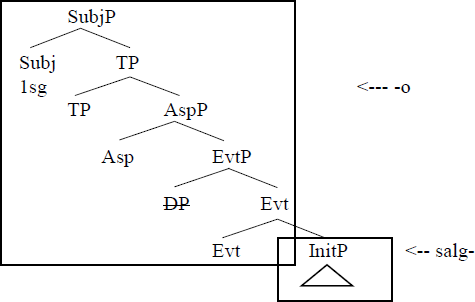
In contrast, in any other present indicative form that uses a subject agreement exponent that does not spell out Evt, the sal- exponent in (59a) will be used.
6 Subjunctives and -g- forms
So what happens in the subjunctive, and what is in fact the connection between 1sg present indicative forms and subjunctive forms?
A relevant property of the subjunctive that connects it to the 1sg present indicative form is that the subjunctive morpheme replaces the theme vowel and, in fact, its phonological shape is sensitive to the value that the traditional ThV has. Verbs that take /a/ in the indicative take /e/ in the subjunctive, and verbs that take /e/ or /i/ in the indicative take /a/ in the subjunctive.
- (61)
- a.
- b.
- c.
- cant-a ‘he sings’
- beb-e ‘he drinks’
- viv-e ‘he lives’
- >
- >
- >
- cant-e ‘he sings.sbj’
- beb-a ‘he drinks.sbj’
- viv-a ‘he lives.sbj’
I propose that these two facts are related to each other: the subjunctive marker in the present is an exponent that spells out a syntactic constituent that starts in a MoodP valued [subjunctive], contains present T and goes down to EvtP, where it is sensitive to the morphological features that determine the conjugation class of the theme vowel.
- (62)
- cant-e ‘he sings.sbj’
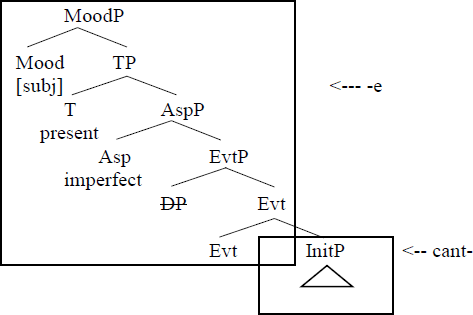
The connection with the -o exponent is that the subjunctive exponents also spell out a complex syntactic tree that starts in Evt. As such, we correctly predict that the -e exponent for subjunctive only appears in the present form. Imperfective subjunctive and so-called future subjunctive restitute the -a ThV of the verb cant-a ‘sing’.
- (63)
- a.
- cant-a-ra imperfective subjunctive
- b.
- cant-a-re future subjunctive
Given this connection between -o and the present subjunctive exponent, in my analysis it is actually expected that verbs that have a -g- exponent for the 1sg present indicative also use the same -g- exponent for the present subjunctive. In both cases, we have situations where the exponent used to spell out the clausal structure consumes Evt, and forces the verbal stem exponent to reduce to InitP. (64) is, then, parallel to (60) above.
- (64)
I believe that in order to relate the three irregularity facts characterising verbs of the sal-i class, it is necessary to adopt an approach like the one I am advocating, specifically one that proposes that ThVs correspond to specific syntactic heads in the structure and explains the relationships that the ThV establishes with other heads through the syntactic configuration. In my view, an approach where the ThV is introduced in a position created ex profeso at PF must treat these facts as unrelated to each other. The reason is that in that type of account there is no way to make exponents compete to spell out the same syntactic head that would correspond to a ThV – in essence because the ThV is not a syntactic head, but corresponds to a syntactically inert position added after syntax.
Let us now address the third irregularity described in section 2.3, the verbs that take -oy as a marker for 1sg present indicative.
7 When the verb cannot be reduced: 1sg forms in -oy
The third irregularity fact involving 1sg forms that we mentioned in section 2 is that some verbs, notably copulative verbs, select a special exponent for the 1sg present indicative form.
- (65)
- a.
- b.
- s(o)-oy
- est(a)-oy
I assume that the exponent -oy /oj/ triggers a phonological operation that removes the final vowel in the verbal stem. This claim is motivated by comparison with the 1pl forms in (66).
- (66)
- a.
- b.
- so-mos
- esta-mos
Despite the historical connection between -oy and -o (cf. Penny 1993), in contemporary Spanish, the form -oy does not exhibit any signs of being decomposable into two units, one of them a bona fide -y morpheme. In particular, in modern Spanish there are no inflected verbal forms *esto or *so for copulative verbs. This contrasts with the impersonal form ha-y, used in locative existential clauses (67a), where the -y can be segmented due to the existence of a personal 3sg form ha (67b).
- (67)
- a.
- Ha-y cosas.
- have-there things
- ‘There are things’
- b.
- Ha comido.
- has eaten
- ‘He has eaten’
I propose that -oy minimally contrasts with -o as a 1sg exponent in having a lexical entry that goes down to AspP, but does not include EvtP.
- (68)
- a.
- b.
As such, (68b) will be used with verbs that spell out EvtP and – crucially – must spell out Evt because they are support verbs that are introduced in this head, as is the case with copulative verbs, which lacks any Init-Proc-Res head in its lexical entry.
My claim, then, is that -oy is used as a way to solve the clash between the 1sg exponent -o and a verbal stem that spells out Evt when the verbal stem cannot function without Evt. In a scenario like (69), the problem is ultimately morphophonological – because the copulative verb is introduced in Evt, using -o completely removes the verbal exponent corresponding to the copulative verb.
- (69)
In that scenario, I argue that the only available solution is to use an exponent that expresses 1sg but does not include EvtP, so that the copulative verb can be introduced as an exponent in Evt. By the Superset Principle, however, -o cannot be used in this structure because its anchor is Evt, and the second exponent, -oy, whose lexical entry does not include Evt is used instead (70).
- (70)
For completeness, there are two more verbs that take -oy: ir ‘to go’ and dar ‘to give’, whose first person singular form is in (71). Let me briefly address them to explain why they also use this exponent, expanding on what I originally said in Fábregas (2017).
- (71)
- a.
- b.
- v-oy
- d-oy
- ‘I go’
- ‘I give’
I am committed to the claim that these two verbs share crucial properties with copulative verbs., Specifically, that like copulative verbs these verbs also spell out EvtP and cannot be reduced to material below EvtP. Although this is a topic for much more detailed research that explores the limits between light verbs and copulative verbs, I believe that there is some initial plausibility to the hypothesis that these two verbs share crucial structural properties with copulas. First of all, note that ir ‘go’ takes the same suppletive form in the perfective as the verb ser ‘to be’. The form in (72) is ambiguous between ‘I was’ and ‘I went’:
- (72)
- fui
Secondly, like the verb estar, the verb dar produces a perfective form that is at odds with what one expects from a verb in the first conjugation – the form *d-a-ste, which one would expect if dar contains a theme vowel, is unattested; d-i-ste ‘you gave’ is the form that emerges. This is what we expect if the final /a/ in this verb is not a theme vowel, but – as I argued for estar – is part of the root. If in dar the final /a/ is part of the root, it follows that its imperative form (73) lacks a theme vowel.
- (73)
- da
- give.2sg.imp
- Give!
Moreover, ir ‘to go’ produces an imperfective indicative form in -ba, which is again at odds with what one expects if the /i/ that we see in the root corresponds to the theme vowel – i-ba is the inflection of an imperfective that one gets with regular verbs of the 1st conjugation (cant-a-ba). As for imperative forms, the verb ir takes a suppletive form ve in the imperative, not the form *va that one would expect if the verb had a theme vowel from the first conjugation.
All in all, the claim that these verbs lack a theme vowel in the present form seems justified, which suggests that these two verbs crucially spell out Evt as part of their verbal stem exponent.
It is tempting to propose that what happens with these verbs is that the material below EvtP is purely prepositional, perhaps a locative structure defined by a path preposition (74). If correct, this would mean that these verbs lack any Init-Proc-Res head, and consequently the verb would need to spell out Evt.
- (74)
However, at this point these are only speculations that will have to be developed in further research.
8 Extensions and conclusion
It is time to conclude. In this article, I have argued that traditional ThVs in Spanish are the spell out of the head Evt. Because the traditional ThV is introduced in one designated syntactic position, a number of inflectional irregularities emerge when there is another exponent that competes with the ThV to spell out Evt.
In essence, the irregularity facts that I have analysed here reflect two solutions to this same problem, once we establish that the 1sg exponent -o spells out a structure that includes all clausal structure between Sbj and Evt. G-marked verbal exponents (salg-) emerge when the competition between -o and the verbal stem is resolved in favour of -o. In these cases, which correspond to situations where the verbal exponent has material in Init-Proc-Res to spell out, the -o 1sg exponent takes Evt and the verbal exponent reduces to Init-Proc-Res. In verbs of the sal-i class, this means using the g-marked exponent. This exponent is also used in present subjunctive forms, because – like -o – the present subjunctive exponent spells out Evt.
In contrast, when there is no Init-Proc-Res material for the verb to spell out – as in the case of copulative verbs – the competition is resolved in favour of the verbal exponent. The exponent that loses the competition is the one corresponding to 1sg inflection. The exponent -o cannot be used in this context, because the lowest node in its lexical entry is Evt and the Superset Principle dictates that it can only be used in situations where Evt is part of its spell out domain. This forces insertion of -oy instead of -o, with -oy being an exponent for 1sg agreement that does not contain Evt in its lexical entry.
8.1 Extensions: other L-shaped irregularities
As I noted in section 2.2 above, the irregularity pattern that involves g-marked verbal exponents like salg- is a particular subcase of the so-called L-shaped irregularity pattern identified in Maiden (1992) for several Romance languages. In my analysis, I have provided an account of the g-marked exponents, but I have not addressed the general problem of L-shaped irregularity patterns. Let me explain why.
In my analysis, it is crucial that the 2sg imperative form lacks a traditional ThV (sal ‘go out!’). This is what my analysis expects if the verbal stem exponent sal- spells out Evt, as the g-exponent salg- is used when Evt is not included in the material spelled out by the lexical verb. However, it is not empirically correct to generalise this pattern to all verbs that follow and L-shaped irregularity pattern in Spanish.
The L-shaped irregularity pattern includes three more classes of verbs, none of which have a 2sg imperative form without a ThV:
i) Verbs that contain the verbaliser suffix -ec-e, such as viejo ‘old’ > envejecer ‘to get old’, which take an extra /k/ segment in the irregular exponent.
- (75)
envejezc-o envejec-e-s envejec-e envejec-e-mos envejec-é-is envejec-e-n envejezc-a envejezc-a-s envejezc-a envejezc-a-mos envejezc-a-is envejezc-a-n
The same pattern is adopted by a small set of verbs that, diachronically, had the Latin antecedent of -ec-e, such as nacer ‘to be born’, conocer ‘to know’.
- (76)
nazc-o nac-e-s nac-e nac-e-mos nac-é-is nac-e-n nazc-a nazc-a-s nazc-a nazc-a-mos nazc-a-is nazc-a-n
ii) Verbs that are formed with the verbal stem -ducir and a prefix (Aronoff 1976) also add an extra /k/ under the same conditions: producir ‘to produce’, reducir ‘to reduce’, conducir ‘to drive’, etc.
- (77)
conduzc-o conduc-e-s conduc-e conduc-i-mos conduc-í-(i)s conduc-e-n conduzc-a conduzc-a-s conduzc-a conduzc-a-mos conduzc-a-is conduzc-a-n
iii) A small set of verbs which have an irregular exponent that adds -ig- or alter the root vowel (78).
- (78)
- a.
- ca-e ‘fall’ > caig-o ‘I fall’, caig-a ‘I fall.sbj’
- b.
- tra-e ‘bring’ > traig-o ‘I bring’, traig-a ‘I bring.sbj’
- c.
- o-i ‘hear’ > oig-o ‘I hear’, oig-a ‘I hear.sbj’
- d.
- cab-e ‘fit’ > quep-o ‘I fit’, quep-a ‘I fit.sbj’
Despite following an L-shaped irregularity pattern, these verbs have imperative forms that contain a ThV:
- (79)
- a.
- ¡Envejec-e! ‘Grow old!’
- grow.old-ThV
- b.
- ¡Produc-e! ‘Produce!’
- produce-ThV
- c.
- ¡Ca-e! ‘Fall!’
- fall-ThV
This means that in my analysis I am not fully covering L-shaped patterns, but only g-marked exponents. I am aware of the existence of alternative analyses to L-shaped patterns. In fact, there is almost complete agreement in the literature that the existence of irregularity models that define specific patterns across cells in a paradigm support a morphomic approach (Aronoff 1994; Trommer 2016). In a morphomic approach, grammar contains specifically morphological features that have no role in syntax or semantics, and whose only function is to determine the morphological shape of some forms.
The account I have sketched in this article tries to derive the irregularity without appealing to this type of purely morphological features, but I have restricted myself to a subset of the L-patterns, specifically those that mark the irregular exponent with -g-. I cannot, then, claim that my analysis makes morphomes redundant in any L-pattern.
However, I would like to sketch a possible extension of my analysis to cover the additional three groups of verbs that follow the L-shaped pattern. One possible move is to split the Evt head in two distinct layers, one designed to introduce the world parameter (w) and a second one whose role is to introduce the time parameter (t). Instead of one head, as in Ramchand (2018), this proposal would follow Nanosyntactic tenets closer, because it would split the two semantic dimensions of Evt in two distinct heads.
- (80)
- Possible division of Evt
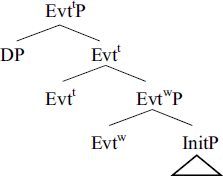
In this extension of the analysis, the sal-i ‘go out’ class of verbs would be verbs whose stem exponent sal- spells out both Evt layers, Evtt and Evtw (81a). This results in 2sg imperative forms without a ThV (81b).
- (81)
- a.
- Revised entry for sal- exponents
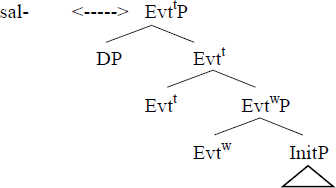
- b.
- Revised spell out of the imperative for sal- exponents
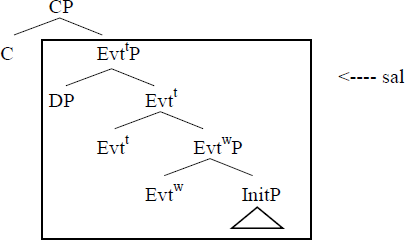
In contrast, the other L-shaped irregular stems mentioned in (i–iii) above would be cases where the verbal stem spells out only the lowest layer of Evt, Evtw, leaving part of the Evt area to be spelled out as a ThV. (82) represents the lexical entry that I propose for the verbal exponent of the three groups of verbs in (i–iii) above, illustrated with ca-e ‘fall’.
- (82)
When introduced in the imperative structure (83), the verbal stem exponent does not consume Evtt, where a ThV -e has to be introduced.11
- (83)
The rest of the analysis for these verbs would be in essence identical to the one proposed in section 5 and section 6 for g-marked exponents – these verbs store a second verbal exponent which only spells out up to InitP, which is caig- in the case of the verb ca-e ‘fall’.
- (84)
I am aware, in any case, that I have not provided independent arguments to support the splitting of Evt into two layers. Therefore, this potential extension should be understood as a speculation that might be worth exploring in further analysis.
8.2 Conclusions
The crucial point that I want to emphasise as a conclusion is that approaches where positions created ex profeso accommodate ThVs cannot connect the irregularities that I have discussed in a principled way – although of course this type of approach can stipulate them as irregular quirks of specific verbs. The reason is that, since a ThV position is created in addition to standard syntactic heads, this type of approach does not predict any type of competition between exponents to lexicalise the syntactic head that spells out as a ThV.
My hypothesis might very well be mistaken, and I have in fact pointed out several complications emerging with it, related to the location of some ThVs in present indicative forms (section 5.1) and the connection between verbs like dar ‘give’ and copulative verbs (section 7). My point is, however, that these complications appear precisely because placing the ThV in the syntax makes rigid predictions about what one expects to find and what should be impossible. A syntactic analysis such as the one I have presented here makes an attempt to relate several patterns of irregularity together, hoping to gain a deeper understanding of the internal structure of verbal inflection. This is, then, opposed to a system that is more powerful in what it can generate because it allows post-syntactic operations that can create additional positions to accommodate morphemes whose syntactic and semantic role is less clear.
My main claim here, perhaps, is that a syntactic analysis of ThVs will always force us to ask deeper questions about the internal structure of inflection. With the shortcomings of my proposal, I hope to at least have shown that this type of approach is worth exploring, because it allows us to tie together a number of properties that would otherwise be treated as unconnected and idiosyncratic irregularities of verbs.
Notes
- Following Bach (1986), I use the term ‘eventuality’ to define the class formed by both dynamic events and states. [^]
- As a reviewer points out, comparison with so-mos suggests that in the 1sg form probably the underlying form is so-oy, with reduction of the /o/ sequence. [^]
- As an anonymous reviewer notes, it would be theoretically more interesting to segment the sequence -uv- that appears in the perfective stems estuv- and anduv-. For the time being, I am treating it as part of an allomorph of the base, but I admit that it could be identified as a spell out of a complex grammatical aspect structure involving a perfective value; in any case, the analysis of -uv- is outside the scope of this article. [^]
- There is another interesting connection, which I will not explore here, between Evt and copulative verbs. In Ramchand (2018), EvtP is identified with the head that other proposals have labelled VoiceP, because one of its functions is to introduce an external argument. Interestingly, the two copulative verbs in Spanish that I am locating in EvtP happen to be also the two verbs used as auxiliaries to build passive voice (i).
- (i)
- a.
- Juan
- Juan
- fue
- was
- atacado.
- attacked
[^]- b.
- El libro ya está escrito.
- the book already is written
- I remain neutral about the difference between ser and estar in syntactic terms. My account is compatible with three analyses, and here I don’t presuppose any of them. Assuming, as is standard, that estar is more complex than ser (eg., Escandell & Leonetti 2002), it might be that Evt has two flavours and estar spells out the value that is richer in (aspectual) features; it might be, along the lines of Uriagereka & Gallego (2016), that estar incorporates prepositional material introduced in the predication structure. Finally, it might be, as Brucart (2012) and Camacho (2012) propose, that estar is the spell out of the EvtP layer plus an interpretable aspectual layer associated with a marked value. What is crucial for me is that these verbs spell out at least Evt, because they are used to introduce the time and world parameters. [^]
- For the purposes of this illustration, I assume that there is no exponent that competes with (19a) to spell out the constituent in (19c). [^]
- While normative grammars advise against the use of -s in the perfective form (cantaste instead of cantastes), it is a common feature of colloquial language to extend -s in 2sg forms also in this temporal form. [^]
- In this form there are additional irregularities. The form di makes it difficult to determine whether the final vowel is part of the root or corresponds to the ThV -i of dec-i. However, a comparison with 2sg regular imperatives of other 3rd conjugation verbs shows that it is more plausible to treat that /i/ as part of the root, as the ThV in 2sg imperative contexts inflects as /e/ (i).
Therefore, I take di to be a truncated form of the root dec-, that is, as a form that lacks a ThV. [^]
- (i)
- viv-i ‘to live’ > viv-e ‘live.imp’
- Interestingly, the verbs that belong to this class also systematically have irregular verbal exponents in the future and conditional forms, which also involve the disappearance of the traditional ThV. If we contrast the future and conditional forms of a regular 3rd conjugation verb like part-i ‘leave’ (ia) with the same forms of a verb like sal-i ‘go out’ (ib) we see that the irregular verbal exponent involves disappearance of the traditional ThV.
This pattern reinforces the proposal that these verbs tend to store exponents that consume Evt and, in general, the ThVs that appear with them are the spell out of clausal nodes corresponding to aspect, tense and mood, all of them located above Evt. [^]
- (i)
- a.
- b.
- part
- sald
- i
- ré
- ré
- ‘I will leave’
- ‘I will go out’
- part
- sald
- i
- ría ‘I would leave’
- ría ‘I would go out’
- An anonymous reviewer correctly notes that all verbs that have an irregular 2sg imperative form are characterised by the ThVs e or i in Spanish, and that no verb with a as a ThV has this irregularity. I admit that this fact is not directly accounted for in my analysis, because I am treating the difference between the three conjugation classes in Spanish as a case of allomorphy – that is, I propose that the three values for the traditional ThV can correspond to the spell out of the Evt head. That said, I think that I can partially account for this generalisation in an indirect way. In my analysis, what seems to be the traditional ThV in verbs like sal-i ‘go out’ that lack a ThV in the 2sg imperative is actually the spell out of present T. If present T can only be spelled out as e/i and the ThV a in the present can only correspond to a spell out of Evt, the generalisation noted by the reviewer can be accounted for. [^]
- This approach, where Evt is split into at least two layers, if on the right track, might provide us with a tool to capture the alternation between the three traditional ThVs syntactically. Remember (cf. 3 above) that I assume for the time being that the three ThVs in Spanish -a, -e and -i, are possible allomorphs of the same head Evt. If Evt is split into two layers, a position closer to Starke’s (2021) analysis of Latin ThVs might be adopted, where -a would correspond to the spell out of the Evtt and Evtw layers and -e/-i correspond to the spell out of the Evtt layer or the T layer (cf. note 10). The unmarked nature of the -a exponent for ThV would follow if most verbal stem exponents spell out only up to InitP, leaving both Evt layers for the ThV to spell out. Note, in this respect, that all verbs that follow the L-shaped irregularity pattern belong to the classes defined by -e or -i as ThVs. What these verbs have in common, in this extension of my analysis, is that their verbal exponent consumes Evtw. [^]
Acknowledgements
I am grateful to three anonymous reviewers and the editors of this monographic issue for very valuable comments and suggestions that have allowed me to improve this article. All disclaimers apply.
Competing interests
The author has no competing interests to declare.
References
Abels, Klaus & Muriungi, Peter K. 2008. The focus marker in Kîîtharaka: syntax and semantics. Lingua 118. 687–731. DOI: http://doi.org/10.1016/j.lingua.2007.09.003
Alexiadou, Artemis & Anagnostopoulou, Elena & Schäfer, Florian. 2015. External arguments in transitivity alternations. Oxford: Oxford University Press. DOI: http://doi.org/10.1093/acprof:oso/9780199571949.001.0001
Arche, María J. 2006. Individuals in time: tense, aspect and the individual/stage distinction. Amsterdam: John Benjamins. DOI: http://doi.org/10.1075/la.94
Aronoff, Mark. 1976. Word formation in generative grammar. Cambridge (Mass.): MIT Press.
Aronoff, Mark. 1994. Morphology by itself. Cambridge (Mass.): MIT Press.
Baker, Mark C. 2002. Lexical categories. Cambridge: Cambridge University Press.
Baunaz, Lena & Lander, Eric. 2018. Nanosyntax: the basics. In Baunaz, Lena & Haegeman, Liliane & DeClercq, Karen & Lander, Eric (eds.), Exploring Nanosyntax, 3–56. Oxford: Oxford University Press. DOI: http://doi.org/10.1093/oso/9780190876746.001.0001
Biezma, María. 2010. On the consequences of being small: imperatives in Spanish. NELS 38. 1–12.
Bonet, Eulàlia. 1991. Morphology after syntax. PhD dissertation, MIT.
Bowers, John. 1993. The syntax of predication. Linguistic Inquiry 24. 591–656.
Bowers, John. 2001. Predication. In Baltin, Mark & Collins, Chris (eds.), The Handbook of Contemporary Syntactic Theory, 299–333. Oxford: Blackwell. DOI: http://doi.org/10.1002/9780470756416.ch10
Brucart, José María. 2012. Copular alternations in Spanish and Catalan attributive sentences. Revista do Estudos Linguísticos da Universidade do Porto 7. 9–43.
Caha, Pavel. 2009. The nanosyntax of case. PhD dissertation, CASTL-University of Tromsø.
Calabrese, Andrea. 2015. Irregular morphology and athematic verbs in Italo-Romance. Isogloss 1. 69–102. DOI: http://doi.org/10.5565/rev/isogloss.17
Camacho, José. 2012. ‘Ser’ and ‘estar’: the individual-/stage-level distinction and aspectual predication. In Hualde, José Ignacio & Olarrea, Ignacio & O’Rourke, Erin (eds.), The Handbook of Hispanic Linguistics, 453–477. Oxford: Blackwell. DOI: http://doi.org/10.1002/9781118228098.ch22
Cardinaletti, Anna. 2004. Toward a cartography of subject positions. In Rizzi, Luigi (ed.), The cartography of syntactic structures vol. 2. The structure of CP and IP, 115–165. Oxford: Oxford University Press.
Carlson, Greggory. 1977. Reference to kinds in English. PhD thesis, University of Massachusetts Amherst.
Escandell, María Victoria & Leonetti, Manuel. 2002. Semántica conceptual/semántica procedimental. In Villayandre Llamazares, Milka (coord.), Actas del V Congreso de Lingüística General, 1727–1738. León: Universidad de León.
Fábregas, Antonio. 2007. The Exhaustive Lexicalisation Principle. Nordlyd 34. 165–199. DOI: http://doi.org/10.7557/12.110
Fábregas, Antonio. 2022. Spanish verbalisations and the internal structure of lexical predicates. London: Routledge. DOI: http://doi.org/10.4324/9781003286455
Fábregas, Antonio & González Rodríguez, Raquel. 2020. On inhibited eventualities. Natural Language and Linguistic Theory 38. 729–773. DOI: http://doi.org/10.1007/s11049-019-09461-y
Garet, P. 2021. Le verbe -IR. Une étude morphosyntaxique et phonologique de verbes français construits sur la racine is/z. Ph. D. thesis, Université de Paris Cité.
Harley, Heidi. 2013. External arguments and the Mirror Principle. On the distinctness of Voice and v. Lingua 125. 34–57. DOI: http://doi.org/10.1016/j.lingua.2012.09.010
Isac, Daniela. 2015. The morphosyntax of imperatives. Oxford: Oxford University Press. DOI: http://doi.org/10.1093/acprof:oso/9780198733263.001.0001
Kayne, Richard S. 2016. What is suppletive allomorphy? On ‘went’ and *’goed’ in English. Ms., NYU.
Maiden, Martin. 1992. Irregularity as a determinant of morphological change. Journal of Linguistics 28. 285–312. DOI: http://doi.org/10.1017/S0022226700015231
Maiden, Martin. 2018. The Romance verb. Morphomic structure and diachrony. Oxford: Oxford University Press. DOI: http://doi.org/10.1093/oso/9780199660216.001.0001
Noyer, Rolf. 1997. Features, positions and affixes in autonomous morphological structure. New York: Garland.
Oltra-Massuet, Isabel. 1999. On the notion of theme vowel: A new approach to Catalan verbal morphology. MIT Occasional Papers in Linguistics 19. Cambridge (Mass.): MIT.
Oltra-Massuet, Isabel & Arregi, Karlos. 2005. Stress-by-structure in Spanish. Linguistic Inquiry 36. 43–84. DOI: http://doi.org/10.1162/0024389052993637
Penny, Ralph. 1993. Gramática histórica del español. Barcelona: Ariel.
Picallo, Carme. 1991. Nominals and nominalizations in Catalan. Probus 3. 279–316. DOI: http://doi.org/10.1515/prbs.1991.3.3.279
Ramchand, Gillian. 2018. Situations and syntactic structures. Cambridge (Mass.): MIT Press. DOI: http://doi.org/10.7551/mitpress/9780262037754.001.0001
Starke, Michal. 2009. Nanosyntax: A Short Primer to a New Approach to Language. Nordlyd 36. 1–6.
Starke, Michal. 2021. Normalizing theme vowels. Talk presented at Workshop Theme vowels in (V)P Structure and beyond, University of Graz (online), Austria, April 22–23.
Taraldsen Medová, Lucie & Wiland, Bartosz. 2019. Semelfactives are bigger than degree achievements. Natural Language and Linguistic Theory 37. 1463–1513. DOI: http://doi.org/10.1007/s11049-018-9434-z
Trommer, Jochen. 2016. A post-syntactic morphome cookbook. In Siddiqi, Daniel & Harley, Heidi (eds.), Morphological Metatheory, 59–94. Amsterdam: John Benjamins. DOI: http://doi.org/10.1075/la.229.03tro
Uriagereka, Juan & Gallego, Ángel. 2016. ‘Estar’ = ‘ser’ + P. Borealis 5. 123–156. DOI: http://doi.org/10.7557/1.5.1.3634
Zanuttini, Rafaela. 1997. Negation and clausal structure. Oxford: Oxford University Press.

